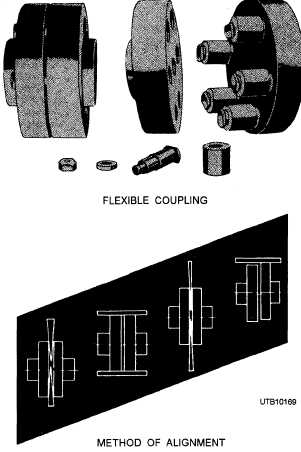common problem in the case of grease-lubricated bearings. Too much grease around the bearings insulates and seriously hinders the conduction of heat away from the bearing. The specific lubrication requirements and inspection procedures vary according to the type of bearings and the motor installation. You should always consult your local operator maintenance schedules and instructions for guidance. Other than the inspections cited, the operator should check for the leakage of lubricants from the bearings, especially lubricant oozing toward the windings or other electrical conductors.
At less frequent intervals, maintenance schedules require additional and more detailed inspections for proper lubrication. This requirement often includes dismantling parts of the bearing housing because bearing housings and pressure fittings must be cleaned periodically.
To lubricate grease-lubricated bearings properly, you must flush old grease from the bearing with solvent and add fresh grease. Sleeve bearings must be examined at various intervals and the oil reservoir flushed, cleaned, and refilled.
MAINTENANCE AND ALIGNMENT OF DRIVES. - The mechanism, or linkage, that transmits the motion and the power of the prime mover to the driven equipment is the drive. The drive must be maintained and operated properly, because its alignment and mechanical efficiency affects both the prime mover and the driven equipment. Two fairly common types of drives used with electric motors are the flexible coupling and the belt drive.
The coupling shown in figure 6-4 connects or couples the shaft of the prime mover to the shaft of the driven equipment. The coupling is designed to permit very slight misalignment between the two shafts. This flexibility permits the coupling to absorb some of the torque, or twisting force, resulting from the inertia of the driven equipment when the motor is started and brought up to speed. Caution must be taken, because any misalignment in excess of these small tolerances causes rapid wear of the coupling hubs and bushing pins, vibration of the shafts, and a reduction in the transmission of power from the prime mover. Vibration is transmitted through the shafts to moving or rotating parts of both the prime mover and the driven equipment. Vibration inevitably results in excessive wear of the various bearings that support the moving or rotating parts, which, in turn, results in more misalignment, vibrations, and wear. The point is that

Figure 6-4. - Coupling.
small vibrations, which at first may seem insignificant, can develop into major casualties and breakdowns.
While the motor is in operation, check the coupling for any unusual noise or vibration. At prescribed intervals, maintenance schedules require the operator to check the alignment of the coupling with a straightedge, a dial indicator, a thickness gauge, or a wedge, and realign the coupling as necessary. For detailed instructions for the proper realignment procedure, consult the manufacturer's instructions.
Various belt and pulley arrangements are also used as drives on electric motors. These belt drives are somewhat similar to the fan belt arrangements that drive the fan, the water pump, and the alternator on automobiles. The belt, made either of rubber or leather, rides on grooved pulleys or sheaves-one sheave connected to the shaft of the prime mover and the other sheave connected to the shaft of the driven equipment. In this way, the rotation of the electric motor is transmitted to the shaft of the driven equipment.
Continue Reading